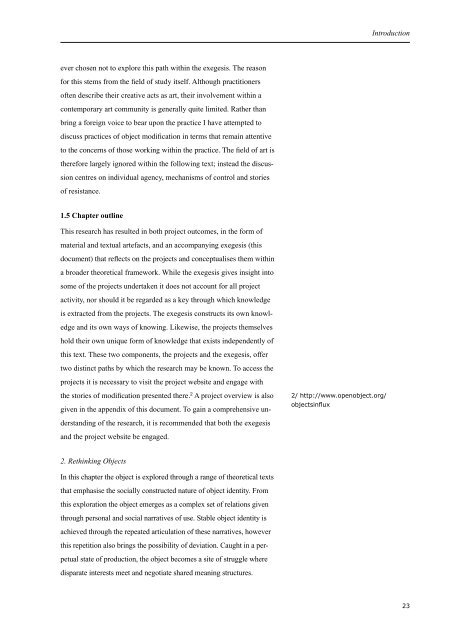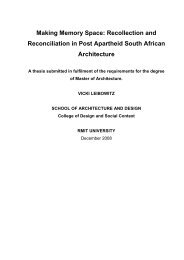Objects in Flux - RMIT Research Repository - RMIT University
Objects in Flux - RMIT Research Repository - RMIT University
Objects in Flux - RMIT Research Repository - RMIT University
Create successful ePaper yourself
Turn your PDF publications into a flip-book with our unique Google optimized e-Paper software.
ever chosen not to explore this path with<strong>in</strong> the exegesis. The reason<br />
for this stems from the field of study itself. Although practitioners<br />
often describe their creative acts as art, their <strong>in</strong>volvement with<strong>in</strong> a<br />
contemporary art community is generally quite limited. Rather than<br />
br<strong>in</strong>g a foreign voice to bear upon the practice I have attempted to<br />
discuss practices of object modification <strong>in</strong> terms that rema<strong>in</strong> attentive<br />
to the concerns of those work<strong>in</strong>g with<strong>in</strong> the practice. The field of art is<br />
therefore largely ignored with<strong>in</strong> the follow<strong>in</strong>g text; <strong>in</strong>stead the discussion<br />
centres on <strong>in</strong>dividual agency, mechanisms of control and stories<br />
of resistance.<br />
1.5 Chapter outl<strong>in</strong>e<br />
This research has resulted <strong>in</strong> both project outcomes, <strong>in</strong> the form of<br />
material and textual artefacts, and an accompany<strong>in</strong>g exegesis (this<br />
document) that reflects on the projects and conceptualises them with<strong>in</strong><br />
a broader theoretical framework. While the exegesis gives <strong>in</strong>sight <strong>in</strong>to<br />
some of the projects undertaken it does not account for all project<br />
activity, nor should it be regarded as a key through which knowledge<br />
is extracted from the projects. The exegesis constructs its own knowledge<br />
and its own ways of know<strong>in</strong>g. Likewise, the projects themselves<br />
hold their own unique form of knowledge that exists <strong>in</strong>dependently of<br />
this text. These two components, the projects and the exegesis, offer<br />
two dist<strong>in</strong>ct paths by which the research may be known. To access the<br />
projects it is necessary to visit the project website and engage with<br />
the stories of modification presented there. 2 A project overview is also<br />
given <strong>in</strong> the appendix of this document. To ga<strong>in</strong> a comprehensive understand<strong>in</strong>g<br />
of the research, it is recommended that both the exegesis<br />
and the project website be engaged.<br />
2. Reth<strong>in</strong>k<strong>in</strong>g <strong>Objects</strong><br />
In this chapter the object is explored through a range of theoretical texts<br />
that emphasise the socially constructed nature of object identity. From<br />
this exploration the object emerges as a complex set of relations given<br />
through personal and social narratives of use. Stable object identity is<br />
achieved through the repeated articulation of these narratives, however<br />
this repetition also br<strong>in</strong>gs the possibility of deviation. Caught <strong>in</strong> a perpetual<br />
state of production, the object becomes a site of struggle where<br />
disparate <strong>in</strong>terests meet and negotiate shared mean<strong>in</strong>g structures.<br />
2/ http://www.openobject.org/<br />
objects<strong>in</strong>flux<br />
Introduction<br />
23
















